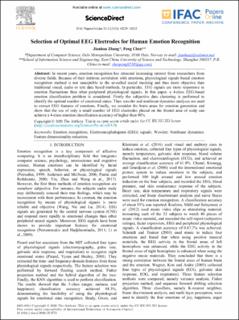| dc.contributor.author | Zhang, Jianhua | |
| dc.contributor.author | Chen, Peng | |
| dc.date.accessioned | 2022-05-03T11:18:46Z | |
| dc.date.available | 2022-05-03T11:18:46Z | |
| dc.date.created | 2022-02-18T16:05:48Z | |
| dc.date.issued | 2021-04-14 | |
| dc.identifier.citation | IFAC-PapersOnLine. 2020, 53 (2), 10229-10235. | en_US |
| dc.identifier.issn | 2405-8963 | |
| dc.identifier.uri | https://hdl.handle.net/11250/2993879 | |
| dc.description.abstract | In recent years, emotion recognition has attracted increasing interest from researchers from diverse fields. Because of their intrinsic correlation with emotions, physiological signals based emotion recognition method is not susceptible to the so-called social masking and thus more objective than traditional visual, audio or text data based methods. In particular, EEG signals are more responsive to emotion fluctuations than other peripheral physiological signals. In this paper, a 4-class EEG-based emotion classification problem is considered. Firstly the subjective data clustering is performed to identify the optimal number of emotional states. Then wavelet and nonlinear dynamics analyses are used to extract EEG features of emotions. Finally, we consider the brain areas for emotion generation and show that the use of only a small number of EEG electrodes placed on the frontal area of scalp can achieve a 4-class emotion classification accuracy of higher than 90%. | en_US |
| dc.language.iso | eng | en_US |
| dc.publisher | International Federation of Automatic Control | en_US |
| dc.relation.ispartofseries | IFAC-PapersOnLine;Volume 53, Issue 2, 2020 | |
| dc.rights | Attribution-NonCommercial-NoDerivatives 4.0 Internasjonal | * |
| dc.rights.uri | http://creativecommons.org/licenses/by-nc-nd/4.0/deed.no | * |
| dc.subject | Emotion recognition | en_US |
| dc.subject | Electroencephalogram signals | en_US |
| dc.subject | Wavelet energy | en_US |
| dc.subject | Nonlinear dynamics | en_US |
| dc.subject | Feature dimensionality reduction | en_US |
| dc.title | Selection of Optimal EEG Electrodes for Human Emotion Recognition | en_US |
| dc.type | Peer reviewed | en_US |
| dc.type | Journal article | en_US |
| dc.description.version | publishedVersion | en_US |
| dc.rights.holder | © 2020 The Authors | en_US |
| cristin.ispublished | true | |
| cristin.fulltext | original | |
| cristin.qualitycode | 1 | |
| dc.identifier.doi | https://doi.org/10.1016/j.ifacol.2020.12.2753 | |
| dc.identifier.cristin | 2003477 | |
| dc.source.journal | IFAC-PapersOnLine | en_US |
| dc.source.volume | 53 | en_US |
| dc.source.issue | 2 | en_US |
| dc.source.pagenumber | 10229-10235 | en_US |

